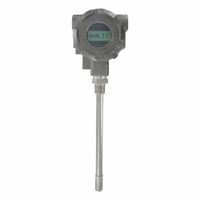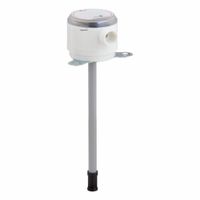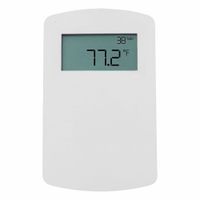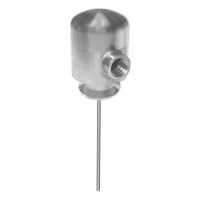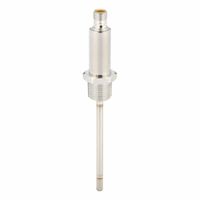Call +(254) 703 030 000 / 751 483 999 / 721 704 777
- Home
- Test Instruments
- Temperature And Environmental Measurement
- Temperature Humidity Transmitters
.....Read More
Frequently Asked Questions
What is a temperature and humidity transmitter?
A temperature and humidity transmitter is a device designed to measure and transmit data regarding the ambient temperature and relative humidity of an environment. These devices are essential in various applications, including HVAC systems, industrial processes, agriculture, and meteorology, where maintaining specific environmental conditions is crucial.
The transmitter typically consists of sensors that detect temperature and humidity levels. The temperature sensor often uses thermistors, thermocouples, or resistance temperature detectors (RTDs) to measure the ambient temperature. For humidity, capacitive, resistive, or thermal conductivity sensors are commonly used to determine the relative humidity by measuring changes in electrical properties as moisture levels vary.
Once the sensors collect the data, the transmitter processes these signals and converts them into a standardized output, such as a 4-20 mA current loop, voltage output, or digital signals like Modbus or BACnet. This output can then be sent to a display unit, data logger, or control system for monitoring and analysis.
Temperature and humidity transmitters are often equipped with features like calibration capabilities, digital displays, and alarms to alert users when conditions deviate from set parameters. They are designed to be robust and reliable, often housed in weatherproof enclosures to withstand harsh environmental conditions.
In summary, a temperature and humidity transmitter is a critical tool for ensuring optimal environmental conditions in various settings by providing accurate and real-time data on temperature and humidity levels, facilitating effective monitoring and control.
How do temperature and humidity transmitters work?
Temperature and humidity transmitters are devices used to measure and transmit data about environmental conditions. They typically consist of sensors, a processing unit, and a communication interface.
Temperature sensors often use thermistors, RTDs (Resistance Temperature Detectors), or thermocouples. Thermistors change resistance with temperature changes, RTDs use metals like platinum to measure resistance changes, and thermocouples generate a voltage based on temperature differences between two dissimilar metals.
Humidity sensors, or hygrometers, commonly use capacitive, resistive, or thermal methods. Capacitive sensors measure changes in capacitance caused by humidity-induced changes in a polymer or metal oxide layer. Resistive sensors detect changes in electrical resistance due to moisture absorption. Thermal sensors measure humidity by detecting changes in thermal conductivity.
The processing unit in the transmitter converts the raw sensor data into a standardized output signal. This unit often includes analog-to-digital converters, microcontrollers, and signal conditioning circuits to ensure accurate and reliable data.
The communication interface transmits the processed data to a display, control system, or data logger. Common communication protocols include 4-20 mA current loops, voltage outputs, RS-485, Modbus, and wireless options like Bluetooth or Wi-Fi.
Temperature and humidity transmitters are used in various applications, including HVAC systems, industrial processes, meteorology, and environmental monitoring. They provide critical data for maintaining optimal conditions, ensuring safety, and improving energy efficiency.
What are the applications of temperature and humidity transmitters?
Temperature and humidity transmitters are essential in various industries for monitoring and controlling environmental conditions. Here are some key applications:
1. **HVAC Systems**: In heating, ventilation, and air conditioning systems, these transmitters ensure optimal indoor air quality and comfort by regulating temperature and humidity levels.
2. **Agriculture**: They help in maintaining the right climate conditions in greenhouses and storage facilities, ensuring crop health and longevity.
3. **Pharmaceuticals**: In pharmaceutical manufacturing and storage, precise temperature and humidity control is crucial to maintain the efficacy and stability of drugs.
4. **Food and Beverage**: These transmitters are used in food processing and storage to prevent spoilage and ensure safety by maintaining appropriate environmental conditions.
5. **Data Centers**: To prevent overheating and equipment failure, data centers use these devices to monitor and control the temperature and humidity levels.
6. **Museums and Archives**: They help preserve artifacts, documents, and artworks by maintaining stable environmental conditions, preventing damage from fluctuations in temperature and humidity.
7. **Industrial Processes**: In various manufacturing processes, maintaining specific temperature and humidity levels is critical for product quality and process efficiency.
8. **Healthcare**: Hospitals and laboratories use these transmitters to ensure a sterile and controlled environment, crucial for patient safety and accurate test results.
9. **Meteorology**: They are used in weather stations to collect data for weather forecasting and climate research.
10. **Building Automation**: Integrated into smart building systems, they contribute to energy efficiency and occupant comfort by optimizing environmental controls.
These applications highlight the importance of temperature and humidity transmitters in ensuring operational efficiency, product quality, and safety across diverse sectors.
How do you install a temperature and humidity transmitter?
1. **Select Location**: Choose a location away from direct sunlight, heat sources, and moisture to ensure accurate readings. Ensure the area has good air circulation.
2. **Mounting**: Use the provided brackets or screws to mount the transmitter securely on a wall or a pole. Ensure it is at an appropriate height for the environment being monitored.
3. **Power Supply**: Connect the transmitter to a power source. This could be a battery, a solar panel, or a direct electrical connection, depending on the model. Ensure the power supply matches the transmitter's requirements.
4. **Wiring**: If the transmitter requires wiring, connect the wires according to the manufacturer's instructions. This typically involves connecting the power, ground, and signal wires to the appropriate terminals.
5. **Calibration**: Calibrate the transmitter if necessary. Some models come pre-calibrated, while others may require manual calibration using a reference device.
6. **Configuration**: Use the transmitter's interface or a connected device to configure settings such as measurement intervals, units of measurement, and alarm thresholds.
7. **Testing**: Once installed, test the transmitter to ensure it is functioning correctly. Check the readings against a known reference to verify accuracy.
8. **Integration**: If the transmitter is part of a larger system, integrate it with data loggers, control systems, or monitoring software. Ensure proper communication and data transmission.
9. **Maintenance**: Regularly check and maintain the transmitter. Clean the sensor area, replace batteries if applicable, and recalibrate periodically to ensure continued accuracy.
10. **Documentation**: Record installation details, calibration data, and maintenance schedules for future reference.
What are the benefits of using temperature and humidity transmitters?
Temperature and humidity transmitters offer several benefits across various applications:
1. **Accuracy and Reliability**: These devices provide precise and consistent measurements, essential for maintaining optimal conditions in sensitive environments like laboratories, data centers, and manufacturing facilities.
2. **Real-time Monitoring**: Transmitters enable continuous monitoring of environmental conditions, allowing for immediate detection of any deviations from set parameters, which is crucial for preventing damage to sensitive equipment or products.
3. **Data Logging and Analysis**: Many transmitters come with data logging capabilities, enabling historical data analysis. This helps in identifying trends, optimizing processes, and ensuring compliance with industry standards.
4. **Remote Access and Control**: With wireless connectivity, users can access data remotely, making it easier to manage multiple sites or hard-to-reach locations. This feature is particularly beneficial for large-scale operations or geographically dispersed facilities.
5. **Energy Efficiency**: By providing accurate environmental data, transmitters help optimize HVAC systems, leading to reduced energy consumption and cost savings.
6. **Improved Product Quality**: In industries like pharmaceuticals and food processing, maintaining precise temperature and humidity levels is crucial for product quality and safety. Transmitters ensure these conditions are consistently met.
7. **Regulatory Compliance**: Many industries are subject to strict regulations regarding environmental conditions. Transmitters help ensure compliance by providing documented evidence of maintained conditions.
8. **Enhanced Safety**: In environments where temperature and humidity can impact safety, such as chemical plants, transmitters play a critical role in preventing hazardous conditions.
9. **Integration with Automation Systems**: These devices can be integrated into broader building management or industrial automation systems, enhancing overall operational efficiency.
10. **Cost-effectiveness**: By preventing equipment damage, product spoilage, and ensuring energy efficiency, transmitters contribute to significant cost savings over time.
How do you calibrate a temperature and humidity transmitter?
To calibrate a temperature and humidity transmitter, follow these steps:
1. **Preparation**: Ensure the transmitter is clean and in good condition. Gather necessary equipment, including a reference thermometer, a hygrometer, and a calibration chamber or environment with known temperature and humidity levels.
2. **Stabilization**: Place the transmitter in the calibration environment and allow it to stabilize. This may take 15-30 minutes to ensure accurate readings.
3. **Temperature Calibration**:
- Set the calibration chamber to a known temperature.
- Compare the transmitter's temperature reading with the reference thermometer.
- Adjust the transmitter's settings if there is a discrepancy. This is often done through the device's interface or using calibration software.
- Repeat the process at multiple temperature points (e.g., low, medium, high) to ensure accuracy across the range.
4. **Humidity Calibration**:
- Set the calibration chamber to a known humidity level.
- Compare the transmitter's humidity reading with the reference hygrometer.
- Adjust the transmitter's settings to correct any discrepancies.
- Repeat at different humidity levels to ensure consistent accuracy.
5. **Documentation**: Record all readings, adjustments, and settings for future reference and compliance with quality standards.
6. **Verification**: After calibration, verify the transmitter's accuracy by comparing its readings with the reference instruments in a controlled environment.
7. **Reinstallation**: Once calibrated, reinstall the transmitter in its operational location, ensuring it is securely mounted and connected.
8. **Regular Maintenance**: Schedule regular calibration checks to maintain accuracy, typically every 6-12 months, depending on the application and manufacturer recommendations.
What are the differences between standard and hazardous location temperature and humidity transmitters?
Standard temperature and humidity transmitters are designed for general-purpose environments where there are no specific risks of explosion or fire. They typically focus on providing accurate measurements of temperature and humidity, with features like digital displays, data logging, and connectivity options for integration with building management systems. These transmitters are used in environments such as offices, warehouses, and residential buildings.
In contrast, hazardous location temperature and humidity transmitters are specifically engineered to operate safely in environments where there are potential risks of explosions due to the presence of flammable gases, vapors, dust, or fibers. These transmitters must comply with stringent safety standards and certifications, such as ATEX, IECEx, or FM, which dictate their design and construction to prevent ignition sources. They often feature explosion-proof or intrinsically safe designs, which may include sealed enclosures, non-sparking materials, and energy-limiting circuits.
The key differences between the two types of transmitters include:
1. **Design and Construction**: Hazardous location transmitters have robust, explosion-proof enclosures and components to prevent ignition, while standard transmitters do not require such features.
2. **Certification and Compliance**: Hazardous transmitters must meet specific safety standards and certifications, whereas standard transmitters do not.
3. **Cost**: Due to their specialized design and compliance requirements, hazardous location transmitters are generally more expensive than standard ones.
4. **Installation and Maintenance**: Hazardous transmitters require careful installation and maintenance by trained personnel to ensure safety, while standard transmitters have simpler installation and maintenance procedures.
5. **Application**: Hazardous transmitters are used in industries like oil and gas, chemical processing, and mining, whereas standard transmitters are used in non-hazardous environments.
